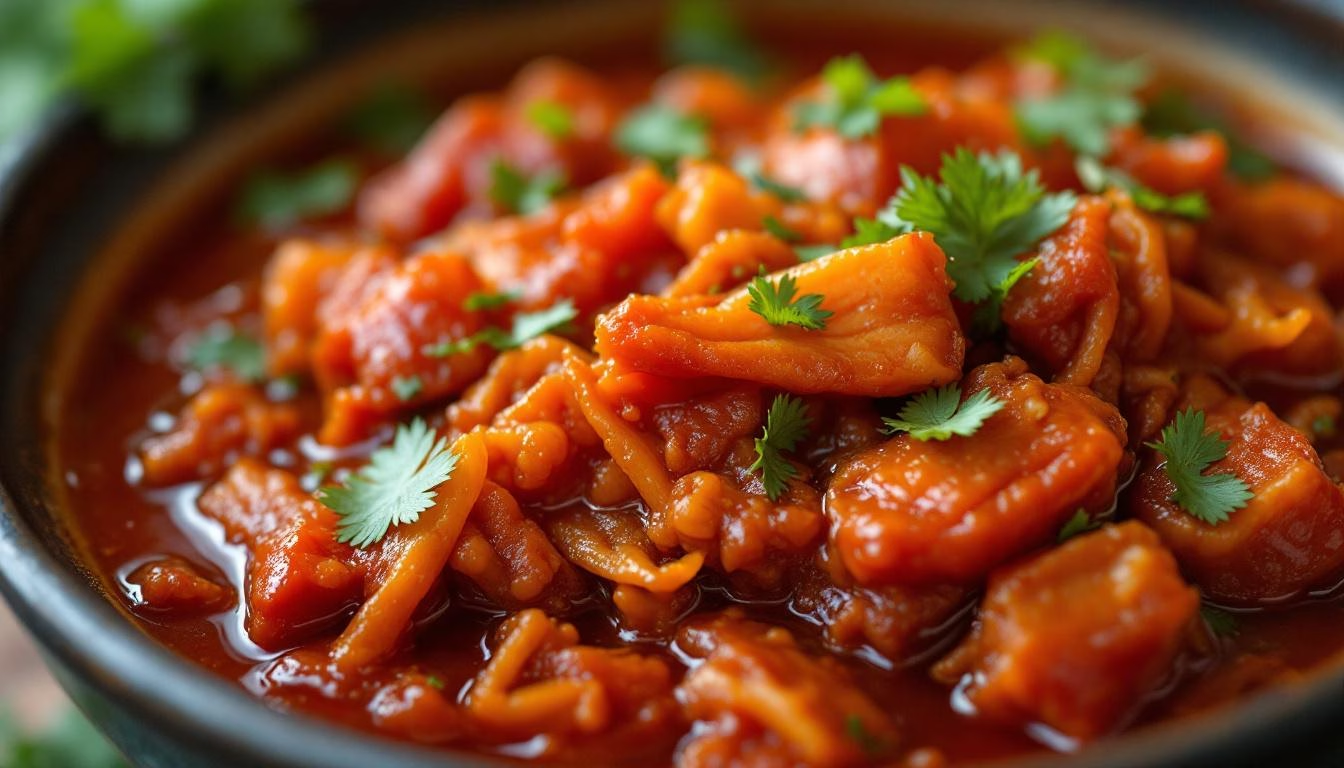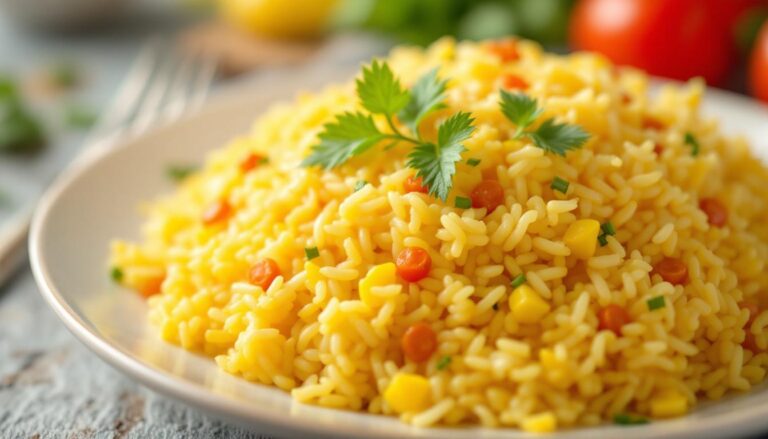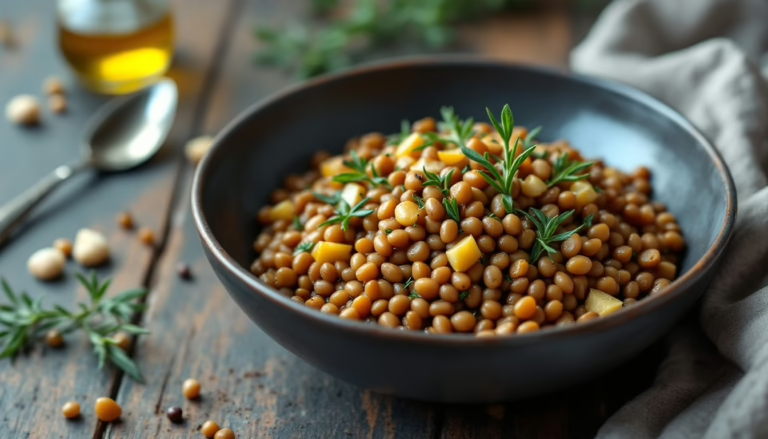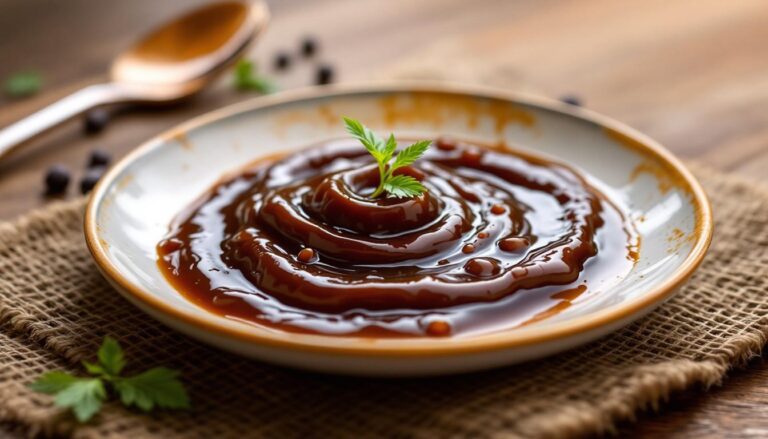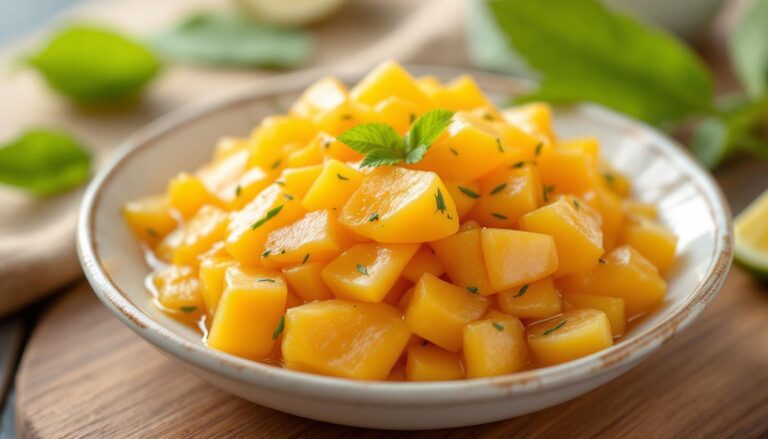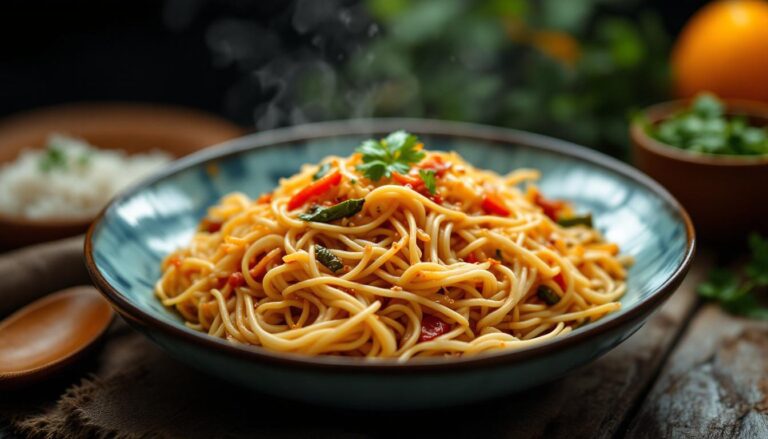Sambal Dabu Dabu: Indonesian Spicy Raw Sambal Recipe
Fresh Indonesian Sambal Dabu Dabu Recipe: The Raw Condiment That Changes Everything – I used to be one of those people who thought all good condiments needed to be cooked.

Sambal Dabu Dabu (Indonesian spicy raw sambal from Manado)
Ingredients
- 3 bird’s eye chillies (minced)
- 1 Korean chili (or Fresno chili, thinly sliced)
- 2 green chilies (hari mirch, thinly sliced)
- 1 clove garlic (minced)
- 4 shallots (thinly sliced)
- 1 cup tomato (diced)
- ½ teaspoon salt (or to taste)
- 1 teaspoon palm sugar (brown sugar, or coconut sugar)
- 3 tablespoons oil (canola, vegetable or sunflower)
- 4 teaspoons lime juice
Instructions
- Finely chop the bird's eye chilies, Korean chili (or Fresno chili), green chilies, garlic, shallots, and tomato.
- In a mixing bowl, combine the prepared vegetables with the salt (adjusted to your preference) and sugar.
- Heat the cooking oil in a saucepan over high heat for 90 seconds.
- When the oil is hot, pour it over the seasoned vegetables.
- Stir in freshly squeezed lime juice.
- Serve fresh, or pack in an airtight container to use within two days.
Nutrition
You know the type — the ones who turn their noses up at fresh salsas, who insist that “real” hot sauce requires fermentation or at least some time on the stove.
Then I met sambal dabu dabu, and honestly, it made me question everything I thought I knew about building flavor.
It happened during a particularly ambitious dinner party phase I went through last spring.
I’d decided to cook my way through Southeast Asian cuisines, one country at a time, because apparently I enjoy making my life unnecessarily complicated.
When I reached Indonesia on my imaginary culinary tour, I stumbled across this Manado-style raw sambal recipe that seemed almost too simple to be good.
Fresh tomatoes, shallots, garlic, a rainbow of chilies, and then — here’s the kicker — you pour hot oil over the whole thing and call it done.
My first reaction was skepticism.
Where was the long simmering?
The careful building of layers?
The Instagram-worthy complexity that makes you feel like a kitchen wizard?
But I was committed to my project, so I grudgingly chopped my vegetables, heated my oil, and prepared to be underwhelmed.
What happened next was basically a flavor revelation that had me questioning my entire approach to condiment-making.
The hot oil didn’t just warm the vegetables — it transformed them, coaxing out their essence while keeping that bright, fresh bite that makes raw preparations so special.
How to Make Authentic Sambal Dabu Dabu (Indonesian Raw Chili Sambal)
Sambal dabu dabu (Indonesian spicy raw sambal from Manado) recipe represents everything I love about Indonesian cooking — it’s bold, it’s practical, and it doesn’t mess around.
This condiment hails from Manado, the capital of North Sulawesi, where the local cuisine reflects a beautiful blend of Indonesian, Chinese, and Portuguese influences.
Unlike the cooked sambals you might be more familiar with, dabu dabu stays fresh and bright, relying on the shock of hot oil to meld flavors without losing that crisp vegetable texture.
The name itself is wonderfully onomatopoetic — “dabu dabu” supposedly mimics the sound of chopping, which makes perfect sense when you consider that good knife work is really the heart of this recipe.
In Manado, you’ll find this sambal alongside grilled fish, roasted meats, and pretty much anything that benefits from a spicy, acidic kick.
It’s the kind of condiment that makes you want to grill more things just to have an excuse to eat more sambal.
What sets this sambal apart from other fresh condiments is that brilliant hot oil technique.
It’s not quite cooking, but it’s not entirely raw either — it exists in this perfect middle ground where the vegetables soften just slightly while retaining their fresh character.
The oil carries heat and flavor into every piece, creating a condiment that’s both bright and deeply satisfying.
The Essential Sambal Dabu Dabu Recipe
This Sambal Dabu Dabu (Indonesian spicy raw sambal from Manado) recipe serves 14 people generously, though I’ve been known to polish off half a batch by myself when paired with grilled chicken.
The beauty lies in its simplicity — just fresh ingredients, good technique, and the magic of hot oil.
Ingredients You’ll Need
- 3 bird’s eye chilies, minced (these are your heat source, so adjust accordingly)
- 1 Korean chili or Fresno chili, thinly sliced
- 2 green chilies (hari mirch), thinly sliced
- 1 clove garlic, minced
- 4 shallots, thinly sliced
- 1 cup tomato, diced
- ½ teaspoon salt (or to taste)
- 1 teaspoon palm sugar (brown sugar or coconut sugar work too)
- 3 tablespoons neutral oil (canola, vegetable, or sunflower)
- 4 teaspoons fresh lime juice
Step-by-Step Instructions
The key to great sambal dabu dabu is in the prep work — everything needs to be chopped uniformly so it cooks evenly when that hot oil hits.
Prep Your Vegetables
Start by finely chopping all your chilies, garlic, shallots, and tomato.
I cannot stress enough how important uniform cuts are here.
When I first made this, I got lazy with my knife work and ended up with some pieces that were perfectly tender while others remained stubbornly raw.
Take your time — aim for pieces that are roughly the same size, about ¼-inch or smaller.
For the bird’s eye chilies, mince them as finely as you can manage.
These little devils pack serious heat, and you want that fire distributed evenly throughout your sambal.
The Korean or Fresno chili should be sliced into thin rounds, while the green chilies get the same treatment.
Your shallots should be sliced thin — think of how you’d cut them for a salad where you actually want to eat them raw.
Combine and Season
In a mixing bowl, combine all your prepared vegetables with the salt and sugar.
This is where you can start tasting and adjusting — remember, the flavors will intensify once the hot oil hits, but you want a good foundation.
The sugar isn’t meant to make this sweet; it’s there to balance the acid and heat while helping the vegetables release their juices.
Give everything a gentle toss with your hands or a spoon.
You’ll notice the salt starting to draw moisture from the tomatoes almost immediately — this is exactly what you want.
The Hot Oil Magic
Here’s where the real magic happens.
Heat your oil in a small saucepan over high heat for about 90 seconds.
You want it properly hot — not just warm, but actually sizzling hot.
The oil should shimmer and move freely when you swirl the pan.
When the oil is ready, pour it directly over your seasoned vegetables.
You should hear an immediate sizzle, and you’ll see the vegetables brighten and slightly wilt.
This is the moment that transforms your pile of raw vegetables into something extraordinary.
Finish with Lime
Stir in your fresh lime juice immediately while everything is still warm.
The acid will help balance all that heat and add the brightness that makes this sambal so addictive.
Taste and adjust your seasoning — you might want more salt, more lime, or if you’re brave, more chilies.
Pro Tips for Perfect Sambal Dabu Dabu
After making this Sambal Dabu Dabu (Indonesian spicy raw sambal from Manado) recipe more times than I care to admit, I’ve learned a few tricks that make all the difference.
Chili Selection and Heat Management
Not all chilies are created equal, and this is especially true when you’re working with raw preparations.
Bird’s eye chilies are traditional and pack serious heat, but if you can’t find them, Thai chilies work beautifully.
For the Korean or Fresno chili, you want something with moderate heat and good flavor — avoid bell peppers (too mild) or habaneros (too hot and the wrong flavor profile).
If you’re heat-sensitive, start with just one bird’s eye chili and work your way up.
You can always add more heat, but you can’t take it away.
I learned this the hard way during my first attempt when I thought I was tougher than I actually am.
Oil Temperature Matters
The oil needs to be properly hot for this technique to work.
If it’s not hot enough, you’ll just have oily vegetables instead of the slightly cooked, flavor-melded perfection you’re after.
If you don’t have a thermometer, test it by dropping in a small piece of garlic — it should sizzle immediately and vigorously.
Storage and Serving
This sambal is best served fresh, but it will keep in the refrigerator for up to two days in an airtight container.
The flavors actually develop and mellow slightly over time, though you’ll lose some of that bright, just-made freshness.
I usually make it the day I plan to serve it, but day-old sambal dabu dabu is still pretty fantastic.
Knife Skills Make the Difference
I know I mentioned this earlier, but it bears repeating — your knife work really matters here.
Inconsistent cuts mean inconsistent texture and flavor distribution.
If your knife skills aren’t quite there yet, take this as an opportunity to practice.
The repetitive chopping is actually quite meditative once you get into a rhythm.
Creative Variations and Adaptations
While traditional sambal dabu dabu is perfect as-is, there’s room for creativity once you understand the basic technique.
These variations maintain the spirit of the original while adding your own twist.
Fruit-Forward Version
Try adding diced mango or pineapple along with your tomatoes.
The fruit adds sweetness and complexity that pairs beautifully with grilled seafood.
I discovered this variation by accident when I had some slightly overripe mango that needed using up — happy accidents are the best kind.
Herb-Heavy Adaptation
Stir in fresh herbs like cilantro, Thai basil, or mint after adding the lime juice.
The herbs stay bright and fresh, adding another layer of complexity.
This version is particularly good with grilled chicken or fish.
Smoky Variation
Add a finely minced chipotle pepper (from a can in adobo sauce) along with your other chilies.
It’s not traditional, but the smoky heat works surprisingly well with the fresh vegetables.
This version pairs beautifully with grilled meats.
Extra-Garlicky Version
Double or triple the garlic if you’re a garlic lover like me.
The hot oil mellows the raw garlic bite while intensifying the flavor.
This version is perfect for garlic bread or as a pasta sauce base.
What to Expect (And How to Serve It)
Your finished Sambal Dabu Dabu (Indonesian spicy raw sambal from Manado) recipe should be bright, spicy, and incredibly fresh-tasting.
The vegetables will have softened slightly from the hot oil but should still have some bite.
The flavor should be complex — spicy from the chilies, sweet from the tomatoes and sugar, acidic from the lime, and aromatic from the garlic and shallots.
This sambal is incredibly versatile.
In Indonesia, it’s traditionally served with grilled fish, but I’ve found it works beautifully with almost anything that comes off the grill.
It’s fantastic with roasted vegetables, stirred into rice, or even used as a base for salad dressing.
I’ve been known to eat it straight with crackers when I’m feeling particularly indulgent.
The heat level can be intense, especially if you’re not used to bird’s eye chilies.
Don’t be a hero on your first try — start with less and work your way up.
The beauty of this recipe is that it’s so quick to make, you can easily adjust the heat level for your next batch.
Expect this to become one of those condiments you find yourself making regularly.
It’s quick enough for weeknight dinners but special enough for entertaining.
Plus, there’s something deeply satisfying about the simple technique — the way that hot oil transforms a bowl of raw vegetables into something magical never gets old, no matter how many times you make it.


